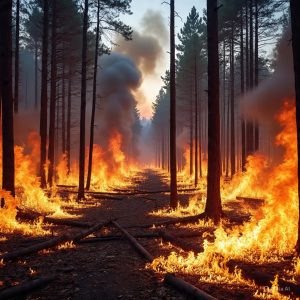
veldfire (photo credit: MetaAI)
BY NYARADZO CHITUNGO
The 2025 veldfire restriction restriction period in Zimbabwe commenced from July 31 and will run up to October 31 2025, in accordance with Statutory Instrument 7 of 2007.
The Environmental Education and Publicity Manager of the Environmental Management Agency (EMA), Amkela Sidange, in a statement announced that the previous year’s restrictions were extended as gazetted by the Minister of Environment.
“In 2024, the fire restriction period was extended from July 1 to November 30, to allow the country to enhance the annual veldfire preparedness and response strategy owing to the impact of the Elnino-induced drought that resulted in the rangeland drying faster and increasing vulnerability to veldfires earlier than statutorily expected.”
She explained that in 2025, the country is entering the restriction period against a veldfire risk prediction of medium to high risk covering 70 percent of the country, a slight decrease from 73 percent in 2024.
The provinces highly exposed to veldfires are along the Highveld areas of Mashonaland Central, Mashonaland East, Mashonaland West, Midlands, and Manicaland.
And the districts that fall in extreme risk are Nyanga, Mutasa, Makoni, Mutare, Chipinge, Chimanimani, Marondera, Chikomba, Hwedza, Murehwa, Zvimba, Hurungwe, Mazowe, Muzarabani, Chirumanzu, and Gweru.
Sidange highlighted that “since the onset of the 2025 veldfire restriction period, the country has recorded 216 veldfire incidences affecting 71,119 hectares, and no major fires were recorded before this period except for insignificant patches mostly attributed to fire guard clearing and in some instances land preparation.”
By the same date last year, the country had lost 393 183.5 hectares from 1 620 fire incidences. The comparative reduction in veldfires to date in 2025 could be attributed to increased resident moisture and green vegetation associated with increase in temperatures in the coming months.
“Vulnerability to veldfires proportionately increase hence the country should remain on high alert to veldfires.
“So far in 2025, the veldfires have been prevalent in Mashonaland West Province (63.50 percent), Mashonaland War (18. 41 percent) and Mashonaland Central Province (7. 76 percent).
“The most affected landuse systems include the resettlement areas of A1 and A2 with (64. 29 percent), followed by Safari areas (20. 79 percent) and Communal Lands (6. 36 percent),” she added.
Sidange pointed out that EMA will continue to monitor fire incidences using satellite near real time technology, awareness raising, field inspections and prosecution as well as collaborative information sharing with stakeholders that include the Ministry of Lands, Agriculture, Water and Fisheries and Rural Development, Ministry of Local Government and Public Works, Non-Governmental Organisation(NGOs), schools, farmers, Zimbabwe Republic Police, traditional leaders and communities among others.
She noted that EMA continues to receive notification requests for block burning in the plantations and gazetted forests for use of fire as a management tool.
“The agency has responded by requesting appropriate detailed fire management plans on such requests pending approvals and discouraging any further delays to block burning as this would increase vulnerability to veldfires in the coming months.”
Sidange encouraged all Government enforced arms to keep an eye on the human related activities that increase veld fire outbreaks in the country.
She also outlined some key points on veldfire management: “understand the Cause: Most veldfires are increasing mainly due to human activities.
“Common causes include lighting fires along road sertudes, careless throwing away of lit cigarette stubs, improper ash disposal and children playing with matches or fire.
“Encourage Fire Prevention: You can encourage people to take precautions. For example, protect your property from veldfires by constructing fireguards. Also encourage your community not to start fires outside residential and business premises during the fire season.
“Reduce Fuel Load: Remind people that flammable materials like grass and shrubs can easily catch fire. Encourage them to reduce “fuel load” around their properties through hay bailing. Thatch and broom grass harvesting also reduces fuel load and the risk of veld fires.
“Be Prepared : In the event of a fire, it’s important to have a preparedness and response plan. Every farm, village and ward should have trained firefighting equipment such as fire beaters, shovels, knap sack sprayers filled with water, among many others,” added Sidange.











